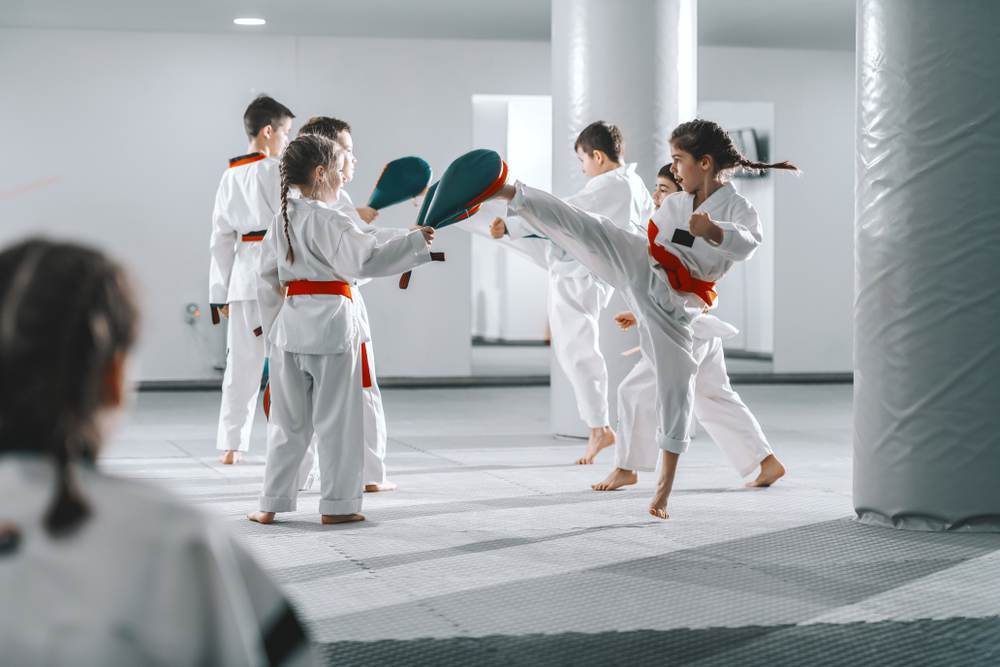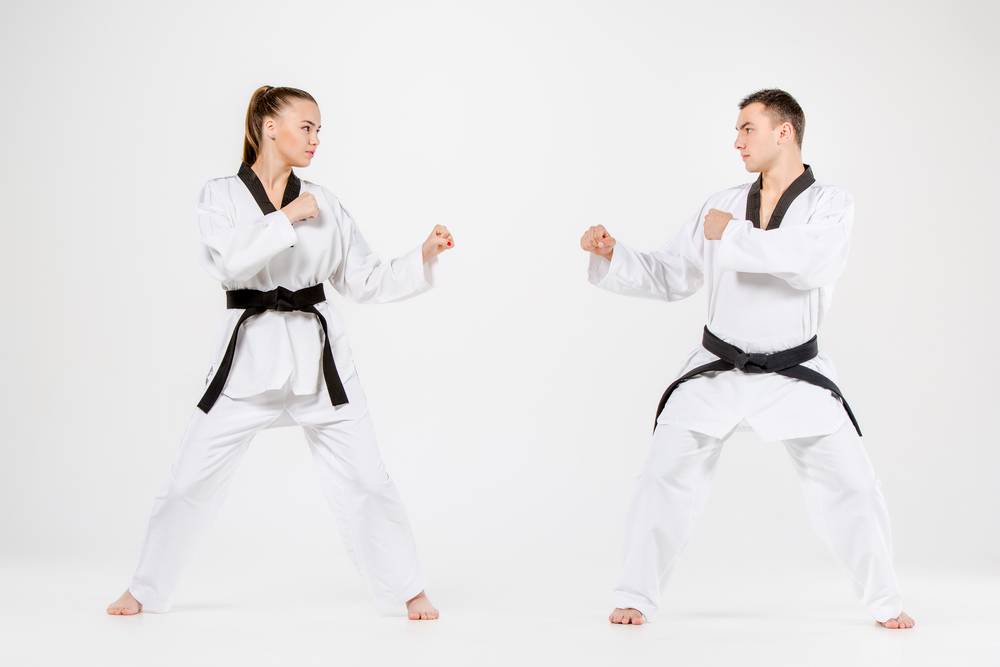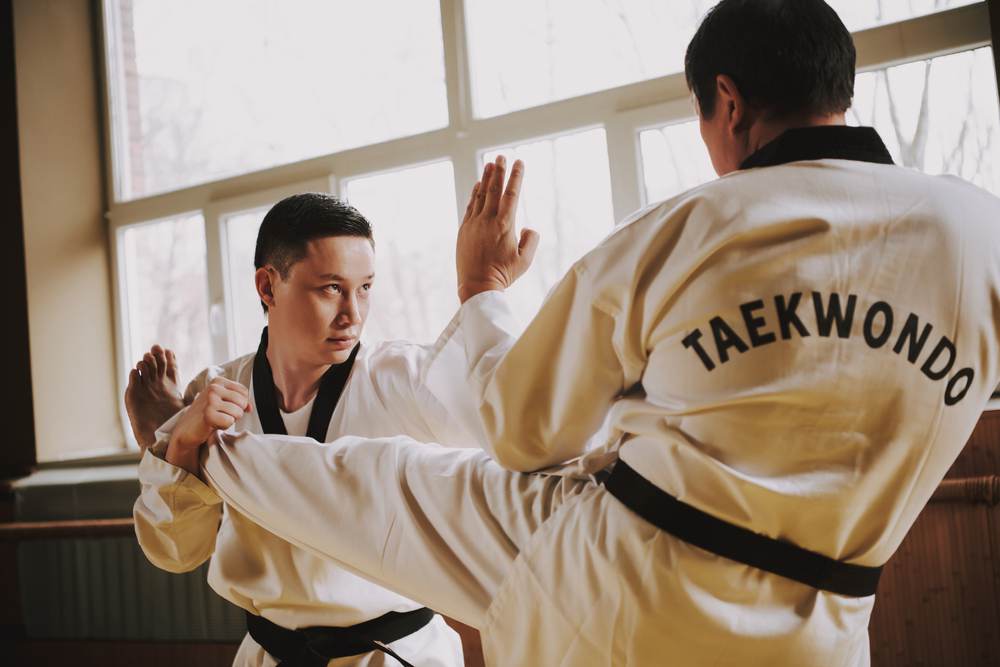As a beginner looking to practice taekwondo, it’s important to know what a typical taekwondo class does so as to know whether it is the right martial art choice for you or your kids. So, what is taekwondo class like?
A typical taekwondo class is a friendly atmosphere that involves bowing, warm-up, punching practice, kicking practice, poomsae, and sparring. It also involves self-defense training and meditation. A normal class should run for 1 hour.
A taekwondo class is really a fun place to be…interestingly, the instructors have a fine way of balancing fun and discipline among students.
Now, relax as I explain in detail what a taekwondo class is all about and what to expect as you progress through the ranks.
Let’s begin.
What Are Taekwondo Lessons Like?
A taekwondo class is made up of eleven primary elements.
Although the focus of each class will vary according to the instructor, these eleven elements will always be included in the overall curriculum of a school of taekwondo:
- Bowing
- Warm-up
- Blocking practice
- Punching practice
- Kicking practice
- Forms practice
- Self-defense training
- One-step sparring
- Three-step sparring
- Sparring
- Meditation
A taekwondo class begins when the students are called together by the instructor.
The students line up in the appropriate location designated by the school.
The senior students are always in front of the class. From there, the students fall into place in accordance with their belt ranking.
For example, the black belts will be in the front of the class, followed by the red belts, the blue belts, the yellow belts, and finally the white belts.
When several members of the school possess the same belt ranking, their order is determined by who has been a student of the school for the longest period of time.
Bowing
Once the class has lined up, the instructor directs the students to face the flags.
The flag of the home country and the flag of South Korea commonly hang on the walls of most dojangs.
The students are then directed to bow to the flags.
A bow, in taekwondo, is accomplished by placing your hands, palms down, against your upper legs. You then slightly bend forward at waist level.
Once the bowing to the flags has been completed, the students are instructed to turn and face the instructor. They bow to the instructor, as he bows to them.
The class may now get underway.
Kihap
One commonly hears taekwondo practitioners performing a martial arts yell as they perform a technique.
This yell is known in Korean as a kihap.
The kihap is actually a conscious method for taekwondo practitioners to expel ki, internal energy, from their bodies as they perform a technique. This is understood to give the technique more power and cause practitioners to remain more focused.
You perform the kihap by releasing your breath, in the form of a yell, from your central abdominal region as you perform each technique.
All taekwondo students are instructed to perform a kihap in association with each technique they perform.
Therefore, it is a good idea for the budding taekwondo practitioner to get into the habit of performing the kihap from the very beginning of training.
Warmup
A taekwondo class begins with various forms of warmup exercises.
The first traditional method of warming up is the horse stance middle punch (see
This exercise has the students enter into a horse stance and punch toward a central point.
Once this exercise is completed, the students are then directed to do push-ups on their knuckles.
Commonly, the student is told to do ten push-ups.
Back on their feet, the class is then led through a series of leg-stretching exercises.
As one of the elemental components of taekwondo is kicking, stretching is an essential part of the warm up.
Stretching diminishes the chances that students will tear muscles while training.
Blocking Practice
Blocking practice is usually the next level of training for the taekwondo class.
Not only does blocking practice help to refine the students’ skills, but it helps in the ongoing process of warming up.
What commonly occurs in blocking practice is that the instructor will direct the students to perform one of the taekwondo blocks: a low block, a high block, and so on.
As each block is shouted out, the students will move forward and kihap while performing the individual block.
When the lead member of the class reaches the wall, they will be instructed to pivot and turn around.
The practice session will then continue, going the other way.
In some cases, where there is not adequate space for the students to move forward in lines, they will simply perform each block where they stand.
When they are instructed to perform the next blocking technique, they will simply switch legs in a low jumping pattern, so that their rear leg takes the forward position.
Punching Practice
Punching practice is usually the next level of training the class is guided through.
To begin this segment of the class, the instructor will call out a command.
For example, “Front stance, straight punch.” With this, the students will kihap and follow through with the technique.
The instructor will call out, “One, two, three, four,” and the students will move forward, performing the technique, until they are instructed to perform another punching technique or to stop.
Incorporating Punching with Blocking
It is common in a taekwondo class to mix blocks and punches at the beginning training session.
For example, an instructor may call out, “Low block, straight punch.” With this, the class will move forward, performing a low block, then step forward while performing a straight punch.
From this, the students begin to learn how various combinations work together.
Thereby, they begin to understand that no taekwondo technique is whole and complete unto itself.
Kicking Practice
At the heart of taekwondo is its extensive kicking arsenal. For this reason, a large portion of every class is devoted to developing the legs.
The kicking segment of a taekwondo class commonly begins with the instructor leading the students through the stretch kick.
To perform this kick, practitioners must powerfully lift one leg straight up, in order to gain a forced stretch.
Once this segment concludes, the class will be led through the basic kicks: front kick, side kick, and roundhouse kick.
Although advancing students may question why they must continue to train with kicks they have already learned, continued training reinforces one’s foundation in the art.
In fact, advanced practitioners of taekwondo understand the need to go back and perform the basic kicks every day, to continually refine their advanced technique.
Kicking Drills
Once the various single-kick techniques have been performed, the instructor will lead the class through multiple-kick techniques.
He may call out, “Side kick, right leg, roundhouse kick, left leg.” With this, the class will move forward and perform this combination technique.
Punching and Kicking Drills
Punching may be added to these combinations, as well. The instructor may say, “Axe kick, right leg, back kick, left leg, straight punch, right arm.”
From doing this, the students will learn to integrate punches with their kicking techniques.
Again, this trains the new student in effective taekwondo offensive combinations.
Forms—Poomsae
The Korean word poomsae means “forms,” the predetermined set of defensive and offensive movements.
Poomsae is an essential element of taekwondo. It teaches the students how the various blocks, punches, and kicks are used in association with one another.
At the white-belt level, there are three forms that new students learn to introduce them to the basic blocks, punches, and kicks of taekwondo.
As you advance through the ranks, each belt level has one additional form that is to be learned and mastered.
Within each of these forms, the student is introduced to a new set of blocking, counterstriking, and striking combinations.
This Form training is designed to train the practitioner in the defensive and offensive applications of taekwondo.
During the poomsae segment of the class, one of two scenarios occurs.
In the first, the entire class is directed to perform the prescribed poomsae.
This begins with the class performing the most basic forms.
As the more advanced poomsae are called out, the lower belts sit down to the side of the training area as the higher belts perform their appropriate poomsae.
In the second scenario, individual students are called up and asked to perform the poomsae they are currently working on.
This allows them to receive personal instruction on how their form performance may be improved.
Self-Defense Training
As self-defense is the root of all martial arts training, once the forms segment of the class has been completed, many instructors will lead their students through a session of formalized self-defense techniques.
In these self-defense applications, normally one student is on the offensive, and another on the defensive.
The offensive student grabs the training partner in a specific manner—a choke hold, arm grab, or the like.
The defensive student is then taught to respond to the attack in a very specific manner, ultimately disengaging the hold and striking the opponent in a debilitating manner.
One-Step Sparring
For one-step sparring, the class breaks up into pairs. The students face off.
The offensive student performs a front stance, and low block, followed by a front stance, and middle punch, with a kihap.
The defending student then follows up with the same process.
Once the defending student has signaled his or her readiness, the attacking student unleashes a single punch or kick.
The defensive student then defends against that attack in a predetermined manner.
One-step sparring is made up of predetermined offensive and defensive applications.
For example, the offensive student will perform “Straight punch, number 1.” The defensive student will then counter that attack with a specific block and counterstriking measure. The students will then switch, and the other student will defend against the attack. The pair of students will then move on to “Straight punch, number 2.”
This process will continue until they have worked through all of the one-step sparring techniques appropriate to their belt level.
Three-Step Sparring
For three-step sparring, pairs of students face off.
In this drill, once the defending student has signaled his or her readiness with a down block, middle punch, and kihap, the attacking student unleashes three consecutive offensive techniques.
These may include three kicks, three punches, or a combination of kicks and punches.
Three-step sparring allows students to develop an understanding of combination techniques.
It also teaches them, through actual experience, which offensive technique most easily follows the previous applications.
Sparring
Sparring in a taekwondo class takes place under the strict guidance of the instructor.
Because sparring allows the student to actually experience what works in combative situations, it is an essential element of taekwondo training.
Sparring, in a taekwondo class, is generally limited to
- no-contact sparring or
- semi-contact sparring
In no-contact sparring, the student directs an offensive technique toward a specific location on his or her training partner’s body, and unleashes the technique, but does not actually make forceful contact with the punch or kick.
Semi-contact sparring is generally only allowed once students have advanced through the ranks to the blue-belt level and possess substantially more control over their techniques than novice students.
In this style of sparring, the student directs an attack toward a specific location on the opponent’s body and strikes it lightly.
From this, advancing taekwondo students not only learn to maintain control over their offensive techniques but also develop the ability to target a strike on an opponent exactly.
Full-contact sparring is virtually never taught in the mixed-level taekwondo classroom.
Full-contact training is relegated to a specific class, usually at the black-belt level, where practitioners are trained in strictly competitive taekwondo skills.
Meditation
Meditation is the single most important practice taekwondo stylists can undertake to focus their attention and to heighten their concentration.
Sitting or kneeling meditation is generally performed at the end of a taekwondo class.
As the student’s adrenaline is usually highly aroused by this point, the best style of meditation to perform is to simply close your eyes and consciously take in several very deep breaths.
This will instantly calm you down, refocusing your energy and preparing you for other life activities.
Conclusion
Knowing what a taekwondo class is all about and how it feels helps you determine whether or not you want to move forward with the art.
How, if you finally decide to try out taekwondo below are my guides on…

Hi, my name is Godwin. I am a passionate martial artist with black belts in Taekwondo and Karate. I have over 15 years of martial art experience. I created this platform to enable me to help you learn martial art the right way.





